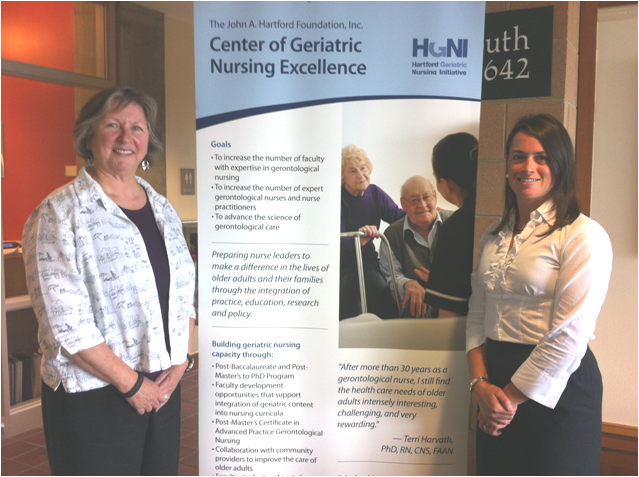In this second part to last week’s post, Common Goals: Partnering with Development Staff for Sustainability in Academic Centers, Rachael Watman continues her interview with the Oregon Health & Science University (OHSU) Foundation’s Rachel Hitchcock, Director of Development, Provost and Schools, and Cathy Kemmerer, Director of Strategic Foundation Partnerships, Office of Corporate and Foundation Relations, to learn more about their best practices as development staff supporting the work of their Hartford Center of Gerontological Nursing Excellence.
Over the past 10 years at the Hartford Foundation, I have been on many site visits. More often than not, it is apparent that Hartford project leadership does not know their university or school’s development team (and vice versa). It is clear that they convene once a year for the annual Hartford site visit. Why do you think there aren’t better relationships between project leaders and the development officers?
It’s difficult to speak to what happens at other institutions. OHSU is fortunate that with the generous support from the Hartford Foundation over the past 13 years, gerontological studies is an area of excellence for nursing—and at OHSU, in general. Thus it grew in prominence as a university priority, most formally with our fundraising effort called the Faculty Support Initiative in 2009. Aging is now considered an ongoing strategic and fundraising priority. This has helped build strong internal and external relationships needed for ongoing effective communication and collaboration. It’s become more integrated in our “core business”—not an annual thing.
Several of us have worked at other universities/organizations, and it is fair to say that OHSU is, in general, a remarkably collaborative environment.
 Dr. Terri Harvath, Center Director, and Rachel Hitchcock, Director of Development, together representing the OHSU Hartford Center of Gerontological Nursing Excellence.
Dr. Terri Harvath, Center Director, and Rachel Hitchcock, Director of Development, together representing the OHSU Hartford Center of Gerontological Nursing Excellence.The Hartford Foundation’s support—and also its commitment to annual site visits—has helped deepen the Center’s engagement with OHSU leadership, including the School of Nursing dean, the OHSU provost, the OHSU president, and the OHSU Foundation president.
How does working with the team at the Hartford Center make your job easier? More enjoyable?
Just being able to say OHSU was named a Hartford Center makes our job easier! Any development officer will tell you that being able to share a really compelling success story made possible by a prestigious national funder makes fundraising easier and more enjoyable.
What would you recommend other development teams do to get to know the project leaders and resources within their institutions? What would you recommend project leaders do to get to know their development teams?
For project leaders, make the time to share your expertise and collaborate with your development team. We are fortunate to have a Center director who understands and appreciates fundraising, and who is willing to meet with anyone. Not all faculty are as interested in meeting with prospective donors, and we are lucky that Dr. Harvath is more than willing to meet with donors and work with us to develop appropriate talking points and ongoing relationship development strategies.
For development officers, ask questions. Working with faculty is a privilege because they have information about areas of knowledge that we—as development people—cannot even begin to consider. One of the most exciting things about being in development in academic health sciences is that every day is truly an opportunity to learn something new. Establish regular communication with your Center team, such as monthly meetings, to ensure fundraising opportunities are consistently on everyone’s radar.
The word “sustainability” is getting a lot of attention these days, especially from funders. What does it mean to you?
For us, it means genuinely ensuring the critical work and impact of the Hartford Center of Gerontological Nursing Excellence can be sustained for generations to come through a variety of philanthropic partnerships and other viable revenue sources.
What should funders know about sustainability and the work of university development offices when making new grants?
Ongoing sustained support, particularly in the early years of a new program, is key. The Hartford Foundation is unique in providing support over a decade’s time, and for us that was critical. We had something great to begin with. Hartford helped us solidify it, expand it, and make it more visible. Over time, this helped the Center be a catalyst for aging efforts across the university and also raised it higher on the radar for university leadership and even in the region, with other academic institutions and local funding partners. It’s challenging to get something that ambitious started and ready to stand on its own legs, so that you develop a track record and something compelling to sustain. And we’re very grateful that the Hartford Foundation provided continued funding to allow us to build the Center to this point.
Academic health systems and health care organizations broadly are in the midst of rapid change and face daunting financial challenges. Fundraising in this environment can be exciting, but is also extremely challenging.
The Hartford Foundation partners with grantees in a variety of ways “beyond the check”—for example, writing letters of support for grants to other funding partners, helping us strategize about aging program development and fundraising (from both private and public sources), and connecting us with other development colleagues who work for other Hartford Centers of Gerontological Nursing Excellence. Funders should know that this broad approach to partnership can really help advance mutual goals.
